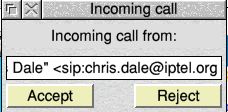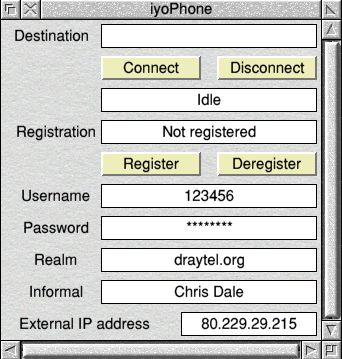

Venue - Methodist Church Hall, Blackwell, Bromsgrove B60 1BL
Guest speaker Chris Dale
8 club members attended
VoIP is Voice over Intenet Protocol. It allows free 'phone calls between VoIP 'phones, and also paid-for calls between VoIP 'phones and PSTN/mobile phones, depending on the type of account you have. There are three ways of using VoIP telephony: You can use the VoIP software and a headset plugged into the Iyonix; or a real VoIP telephone like the Snom300; or some routers have an analogue 'phone socket to plug an ordinary analogue PSTN 'phone into. VoIP uses two separate internet protocols for call setup and for speech.
SIP is used for call set-up and control (Things like: establishing the call; causing the 'phone to ring; telling the far end what type of audio compression to use; that the call has been accepted; and clearing down the call when finished).
RTP is (I think) a subset of UDP (User Datagram Protocol). RTP carries the audio packets. Unlike TCP, UDP packets don't need acknowledgements so they are better for streaming data like audio and video where the loss of an occasional packet doesn't matter too much. So UDP packets have lower latency (delay) than TCP packets. The Iyophone uses only G711µlaw audio compression algorithm. Some VoIP 'phones can also use different algorithms to get better quality audio.
SIP and RTP use different logical 'ports'. For any who don't know about these things, normally the NAT (Network Address Translation) firewall in the router would be set to stop any unrequested packets from the internet getting through to your LAN, but for VoIP telephony there needs to be a way of receiving a call from outside the LAN, so settings need to be changed in the router to allow packets with the right port numbers to pass from the WAN (internet) side to the LAN. This is known as 'Port Forwarding'. For my Netgear DG834G ADSL modem router the 'Services' have to be set first: The Iyophone's default SIP port was already same as I'm using for my Snom300 'phone, which is Port 5060. For the RTP port, I've changed the Iyophone's port to 5004 so it's the same as my Snom 'phone. Next, the router's Firewall settings need to be changed so that the SIP and RTP 'services' are sent to the 'phone's LAN IP address (192.168.0.2 is my Iyonix). I'm not sure what happens if you use DHCP (dynamic port numbers). If you want to change the Iyophone port numbers from the default values, its !Run file can be edited.
An account needs to be set up with a SIP provider and the phone then needs to register (ie: log on) with your SIP provider each time before calls can be made. When the account is set up you will be allocated a password and a user ID which is your 'phone number. In some cases the user ID may be a name rather than a number. When you have your account information from your SIP provider, these details, plus your WAN IP address, need to be entered into Iyophone's main window or, if you want Iyophone to remember them, you can edit the !Run file. You can, if you want, open an account with more than one SIP provider. Many ISPs are also SIP providers.
If you are calling someone else registered with the same provider, you can just 'dial' the number, but if you want to call someone registered with a different provider, eg: Sipgate, you would need to dial for example: 123456@sipgate.co.uk. The SIP provider's server receives your call requests via SIP and routes the request and other call setup information between you and the called number. (Presumably it looks up the called number's IP address). After a VoIP to VoIP call has been set up, the SIP provider's server is out of the loop because the RTP packets go directly between the caller and called party. You can, in theory, call an IP address but I haven't been able to get this to work so far. You'll probably find a list of useful service numbers on the SIP provider's web site which allow you to do things like an echo (latency) test and checking your user ID. If you have a prepaid account you can also call ordinary PSTN or mobile numbers by following the dialling instructions on the provider's web site.
When Iyophone receives an incoming call, a window pops up showing the calling number and you can then choose to accept or reject the call.


Iyophone by Dave Higton, can be downloaded from his website at:
http://www.apts04.dsl.pipex.com/
You will also need to have:
1. Digital Renderer, which is supplied along with UnixLib. (If you use NetSurf, you already have it.)
2. Christian Ludlum's AudioIn module, version 1.01. (Version 1.0 won't do).
3. An analogue headset .
Full instructions come with the software.
This is the manufacturer's webpage for the Snom300 shown at our meeting on 20th November 2010: http://www.snom.com/en/products/ip-phones/snom-300/
I have also used the predecessor to the Grandstream Budge Tone 200 &201:
http://www.grandstream.com/products/consumerphones.html
Here is an example of a VoIP 'phone supplier: http://www.voipon.co.uk/voip-phones-c-1.html
The sell both Snom and Grandsteam VoIP 'phones as well as other makes. You could, of course, shop around for cheaper prices. Snoms are more expensive than Grandstreams. 'Firmware' updates for VoIP 'phones can be downloaded from the manufacturer's web sites.
There are plenty of websites available with further information available about VoIP Telephony. Especially ISPs and SIP providers.